One of the most important challenges that any inbound marketer faces is how to align sales and marketing teams. These departments should act as the spokes of the same wheel and work towards achieving the revenue targets of the organization. Unfortunately, in the real world, this is not true in most cases.
Table of Contents
I will give you an example and my own experience. One client of Inovaticus had large marketing and sales teams. They ran campaigns on Google Ads very aggressively, and in a particular month, around 200–250 leads were generated from these campaigns. The campaigns were quite well designed, and lead qualifiers had been placed on the campaigns and landing pages.
Once collected, the leads went to the sales team for conversion. The problems usually started after this. The sales team started to blame the marketing team for passing on leads that did not convert. The marketing team, on the other hand, started saying that the sales team is ineffective since they cannot close sales from qualified leads that were given to them. The situation often became very bitter, with team reviews becoming as ugly as they could get.
What do you think was the real problem here? It was not one, but many.
- The sales and marketing teams were not aligned for the big picture: achieving organizational targets.
- Each team took a myopic view and was only concerned about achieving their targets.
- A glaring lack of communication. The lead handover process was fully automated through CRM software, and the information was passed mainly through notes and remarks in the CRM software itself.
Ultimately, who suffered? Everyone.
- The organization missed sales and revenue.
- The marketing and sales team members quickly got demotivated due to the blame game. Some of them even started talking about taking leaves on the day of the review.
- The customers suffered too. The organization did not provide them with adequate guidance to complete the buyer’s journey. As a result, they often started taking decisions in favor of other companies in the industry and never returned to this company.
Does this sound very familiar?
87% of the of the terms sales & marketing use to describe each other are negative!
Hubspot
In an ideal situation, sales and marketing should work hand-in-hand with each other to achieve the goals of the organization. However, in reality, many companies do not.
Realign the sales and marketing teams
Aligning the sales and marketing teams is an essential consideration if you want your company to grow, especially with inbound marketing.
You may need to rework the goals of both teams to make them interlinked. That is the starting point for aligning the teams.
Traditionally, the sales funnel that many organizations used to follow had two parts:
- Top of the funnel (comprising mainly of customers who come in for the first time and may or may not ultimately qualify as “Leads”).
- Bottom of the funnel (Qualified leads who ultimately become customers)
The Top of the Funnel (TOFU) was handled by the marketing team, which evaluated and interacted with them as part of the lead qualification process.
The Bottom of the funnel (BOFU) was handled by the sales team.

However, the problem typically arose somewhere in between these two levels, which was somewhat of a gray zone for many. This zone was the handover of leads by the marketing team to the sales team. Millions of leads have been lost just for one simple reason: the ineffective and inefficient handover of the lead from one team to another.
This problem can be solved by creating a layer in the funnel in between the TOFU and BOFU: The Middle of the funnel, or MOFU. This is the zone of active coordination between the Marketing and sales teams to ensure that the lead handover is process-bound, humane, and seamless. This will eliminate the friction between the two groups and increase their confidence in each other.
Above all, this will ensure that the customer gets a uniform experience while dealing with the company.

In the BOFU stage, while handing over the lead, the marketing team will qualify the lead and pass it over to the sales team, detailing the communication they have had with the customer and any other important information that the sales team ought to know.
After this, the sales team will initiate the discussion with the customers and qualify them further. At this stage, if they find that the customer is not worth pursuing, they will inform the marketing team of the reasons for dropping the lead. If the marketing team disagrees, then they can discuss it further to see if the reasons are valid or not. In the end, both need to agree and convince each other regarding whether to pursue or drop the lead.
As you can see, the introduction of this additional level of coordination will ultimately ensure that the teams start trusting each other more, interacting openly, and sharing responsibilities instead of working in silos and blaming each other.
Change The Reporting structure If required.
If you have the sales and marketing teams reporting to different people, then the unification of the working styles may prove difficult. Since both teams are part of the same function, think of making them report to the same person. This will also enable him to act as a pacifier when some inevitable frictions do arise between the teams.
Make Goals transparent
Both the sales and marketing teams should know what the collective target is and how much each team is sharing. At an early stage in the goal-setting process, make this very clear to the teams. Keeping the targets of the other team secret from one team raises the negativity levels. It makes each of them believe that theirs is higher than that of the other team.
Link Incentives To The Achievement Of The Collective goal
This will ensure that they help each other out to achieve their maximum. They need to understand that they will win when the organization wins and fail when even one member of the team fails. So instead of competing with each other, they will start helping the weaker team achieve success.
Encourage Feedback
The senior leadership should always be open to feedback received from the marketing and sales teams. They should act as enablers by providing support, guidance, and technology and by removing obstacles. Through regular meetings, open houses, and mail communications, they should try to figure out ways to help the teams increase the effectiveness of the individual team members as well as the overall process of sales and marketing.
Finally, Celebrate Every Success together
This may sound like a no-brainer, but unfortunately, in many organizations, this is rare. If you do not have this culture in your organization, then go ahead and start it.
Sharing responsibilities, working together, and achieving success together will become even sweeter when the teams get recognized for their efforts. No matter how big or small, give them their due credit. Celebrate even small successes. It will act as a huge morale booster for everyone and prepare them for the challenges ahead.




Leave a Reply